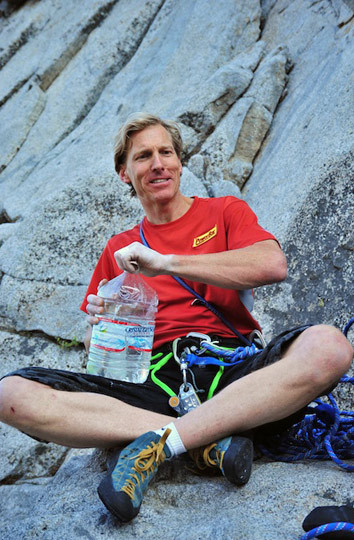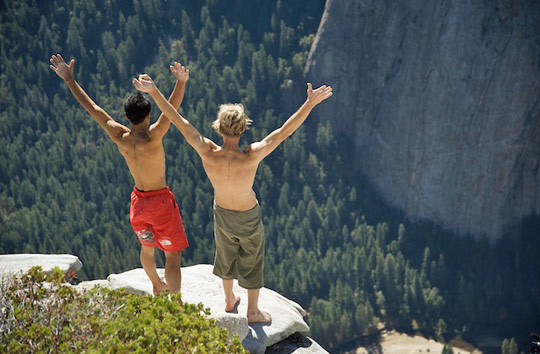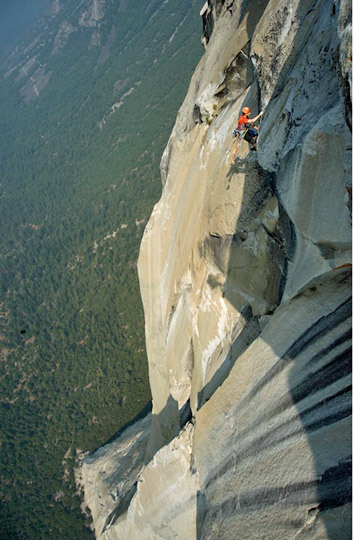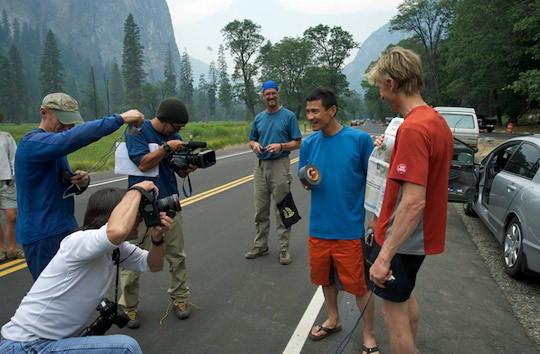
Hans Florine prepares for a speed-ascent of The Nose, El Capitan. Florine has held the speed record seven times and has climbed the route 81 times. [Photo] Paul Hara
Outdoors enthusiasts love to quantify their pursuits. Kayakers measure difficulty with a I-VI class system; BASE jumpers use meters and seconds; even skiers have the D System for quantifying risk, difficulty and length. But no outdoors-person loves to quantify his or her feats more than climbers. From length and commitment to medium and style, climbers have a classification for everything. The growing popularity of speed climbing has brought to the forefront an entirely different way to quantify our sport: time.
Recently, we at Alpinist picked the brains of the speediest climbers to learn more about speed climbing and how it fits into our grade-crazy community.
This week, we sat down with Hans Florine, a Yosemite veteran who holds numerous speed records in the Valley. Florine first broke The Nose speed record in 1990, with a time of 8 hours and 5 minutes. In total, he has held the record seven times and has climbed the route 81 times.
Please tell me about your experience speed climbing in the Valley.
In general, I think we may have [speed climbed] before we called it that. We did it because we liked getting in lots of climbing. That started with zipping up there on weekends from Cal Poly, San Luis Obispo. We were in college, and we wanted to get in as much climbing as we could before classes on Monday. It wasn’t like, “Let’s go try and set some sort of record.” It was like, “We have a limited about of time because we have to get back for classes, so let’s just get in as much climbing as we can.” We never timed how long it took to do a route.
When and why did you start timing your climbs? Had official time records been kept in Yosemite before that?
I think the very first time was the very first time I climbed with [Steve] Schneider in 1990. There were records before that. People like Dave Bengston and Steve Gerberding had been doing single pushes on routes. There was a loose collection of climbing records. I can’t even recall… but it was kind of word-of-mouth I think. That was prior to Internet stuff.
What interested you about speed climbing?
Before I went up The Nose with Steve, the only thing I knew of big-wall climbing was carrying an 80- or 100-pound haul bag to the base–vertical camping. You’re exhausted just getting to the base of the route. I wasn’t so game for that. After doing it once I was like “I’m good with sport climbing or single-pitch trad if I have to deal with this huge haul bag and stuff.”
Obviously big-wall climbing grew on you a bit. You’ve been doing it for quite some time now.
Yeah. Once I had unlocked that gem–you could be up on El Cap with a 10-pound pack on your back instead of an 80-pound. My eyebrows rose up and it was like “Oh we can climb all these big routes here–well, the easy ones at first–in a single push and be back at your car or campsite that night.”
Have you done much speed climbing outside the Valley?
Certainly on competition routes. The one time I went to Patagonia I did it, but down there it was sort of a necessity rather than break some record or another. There the driving force was that you have a window of weather and if you don’t go quick enough then you fail.

Hans Florine and Yuji Hirayama celebrate on the summit of El Capitan on October 28, 2008, having completed the fastest ascent of The Nose with a time of 2:37:05. Two years later, Sean Leary and Dean Potter bested their time by 20 seconds to break the speed record. Read an interview with Leary and Potter in Part II of the Speed Series. [Photo] Paul Hara
Where is the line, or is there a line between alpine climbing and speed climbing? How would you distinguish those two?
[Mark] Twight’s got that line in his book [Extreme Alpinism] a hundred times: “speed equals success.” You just have to move fast in the alpine environment. For example, Alex Lowe was the epitome of being super competitive. He’d do pull-ups and those Russian speed climbing/mountaineering races and all that stuff. But he’s a super friendly, happy-go-lucky guy who was exceptional at alpinism because he knew how to do things efficiently, effectively and all that. So speed climbing and alpinism are mutually agreeable.
What is climbing “about” and how does speed climbing fit into that philosophy?
Your question is two-fold: Is it good for climbing? And what is climbing?
I think climbing is a gazillion different things. It’s applied gymnastics. It’s kind of like the comedian who has some canned joke that he can play. But ad-libbing is going out and onsighting–whether it be sport climbing or alpine routes or bouldering. It’s going out there and applying all the tools you have to a problem.
Addressing it as a physical exercise, it’s one of the only sports that uses the tip of your toes to the tip of your hands to your head. Nothing else really does that.
To answer your first question, “yes,” speed climbing is good for climbing… I think it’s a super objective way to measure how you’re improving. And I do it with hard sport climbing–looking at what kind of mileage of 5.7s I can do, maybe outside or maybe in the gym. In the gym I can check off how many 10s, 11s, 12s, 13s I can do in three or four hours and I can measure that against what I did months ago or in the future and it’s a totally cool, objective tool to see where my climbing fitness level is.

Hans Florine on The Nose of El Capitan. [Photo] Paul Hara
With that sort of objective measurement of success, you inevitably have a sense of competition with yourself and other climbers. You can compare your time or your numbers with other climbers. Do you think it detracts from the sport or do you think it’s a positive thing?
It’s nothing but positive. I do a lot of motivational speaking for folks, and I tell them that you can’t improve things until you start looking at–they call them The Five Ms: measure, monitor, manage, motivate and manifest. If you don’t measure where you’re at, then you don’t know how to motivate or manage or manifest some sort of change. Some people go and climb and think, “Oh, I did a 5.11,” and that might be their loose measurement to see if they improve. But one 5.11 isn’t the same as another 5.11.
Everybody has this urge to improve from 5.10a to 10c or from 5.9 to 5.10, or 12 to 13, or climbing the next hard big-wall route. Climbers have that urge to improve, and that’s nothing more than being–if you want to use the “C word”–competitive with themselves. They’re just trying to improve; they’re not trying to beat anybody else.
Can you please tell me about speedclimb.com? How and why did you start it?
I started it because I saw the reaction from people just getting their names down as having done something. I had just huge numbers of people contacting me saying, “We did this route, that route at this time” and that’s how I filled in that archival information about people climbing different things in Yosemite… I’d get people correcting me on minute differences. It’s cute and interesting that people would care. Invariably you get somebody saying, “You know, these guys reported that they climbed that thing for the first time in-a-day in 1994, but I know somebody who did it in 1982 so they weren’t the first.” Or they find somebody who’s written something in a summit register on one of the 14ers. They climbed something from base camp in six hours or something and they take a picture and send it to me. People find out they weren’t the fastest. I thought that was super interesting and kept the climbing community interested in what they were doing. No one else was doing it at the time–in the late ’90s.

Hans Florine and Yuji Hirayama pose for the cameras after a record-breaking ascent on The Nose. [Photo] Paul Hara
What kind of compromises to your safety, if any, do you make when you’re speed climbing?
Oh that’s a great question. The Nose speed record is a great example… When people sit on The Nose route for four days and they’re belaying somebody on a single pitch for an hour, sometimes two hours, you start kind of looking at the clouds, maybe chatting with the people next to you–maybe not 100 percent attentive on the belay, which isn’t per-say dangerous as long as you have your brake-hand on. But that whole three days that you’re up there, that’s three days that you’re on a 3,000-foot cliff where things can go wrong, as opposed to being on it for six hours only. And in that six hours, or in the case of Dean and Sean who did it in 2 hours, 36 minutes and 50 seconds, or something like that. Those two guys are focused 100 percent of every second of that 2 hours and 36 minutes and 50 seconds on climbing the route. They’re not thinking about their taxes or their girlfriend or anything. They’re thinking about that next placement. That next hand jam and belaying, attentively, the person in the hard section. Although they’re moving and covering more ground than the person who sat on The Nose for three days, they’re 100 percent focused on climbing and nothing else–not watching the clouds or anything else.
So you think it’s safer–or at least safer than climbing the route using big-wall tactics?
After saying what I just did, it is really interesting that the search and rescue folks at Yosemite–this was in 2004 or something–kind of said, “I wonder when we’re going to be rescuing one of you speed climbers.” That’s kind of when it hit me–that analogy I just gave you–it’s like “well, the reason you haven’t is because most speed climbers are really competent.” And there are lots of competent climbers who get in accidents, but they’re usually either guiding somebody or they’re descending or they’re really tired or any number of reasons when it’s user error. And that’s why I, in general, think that speed climbing, to a degree, is going to be safer, more attentive climbing than bumbling around on an A5 for five days or something.
Speed Series Part I: Alex Honnold – “It’s all super safe as long as no one falls.”
Speed Series Part II: Sean Leary and Dean Potter – “We’re always filled with the knowledge that if we fall, it’s a minimum 100-footer and probably way more. You’re going to kill your friend and probably mutilate or kill yourself.”
Speed Series Part III: Ueli Steck – “I think it is nice to be able to climb a peak in several hours instead of several days. You don’t have to suffer so much.”